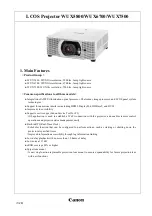
23
... English
Introduction
Viewing 3D Images
The projector provides 3D images to a user wearing
commercially available LCD shutter eyeglasses.
CAUTION
Health precautions
Before viewing, be sure to read health care precautions that may be found
in the user’s manual included with your LCD shutter eyeglasses or your 3D
compatible content such as DVDs, video games, computer’s video files and
the like.
To avoid any adverse symptoms, heed the following:
- Do not use LCD shutter eyeglasses for viewing any material other than 3D
images.
- Allow a distance of 2 m/7 feet or greater between the screen and a user.
Viewing 3D images from too close a distance can strain your eyes. Avoid
viewing 3D images for a prolonged period of time. Take a break of 15
minutes or longer after every hour of viewing.
- If you or any member of your family has a history of light-sensitive seizures,
consult a doctor before viewing 3D images.
- While viewing 3D images, if you get sick such as nausea, dizziness,
queasiness, headache, eyestrain, blurry vision, convulsions, and numbness,
stop viewing them. If symptoms still persist, consult a doctor.
- View 3D images from the front of the screen. Viewing from an angle may
cause fatigue or eyestrain.
LCD shutter eyeglasses
• Use commercially available 3D eyeglasses which meet the
following requirements:
- DLP
®
Link compatible
- Support vertical refresh rate up to 144 Hz.
Steps for viewing 3D images on the projector
1. Connect the projector to your video equipment.
2. Turn on the projector, display the on-screen menu.
3. Select [
3D SETTINGS
] from [
SCREEN
] tab and then select [
ON
]
for [
3D
].
- Set for [
3D INVERT
] and [
3D STRUCTURE
] as necessary. Please
4. Play your 3D compatible content and use the projector to display
the image.
5. Put on your LCD shutter eyeglasses to view 3D images.
Also refer to the user’s manual accompanied with your LCD
shutter eyeglasses for more information.
















































